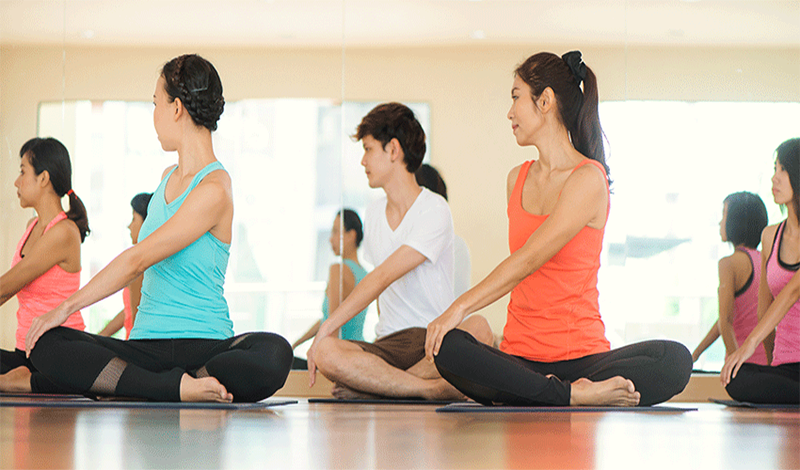
Simple Beginnings
When I began yoga in the late 1990s, it didn’t occur to me to find a class or buy a mat, I just laid out a towel and copied as best I could from a book. About a year later, then in class, I discovered sticky mats, which, back then, was really carpet underlay. Other props did not exist in my consciousness.
I grew up in a pretty normal English home; we had tables, chairs and a sofa, so aged eighteen, squatting at the Kathmandu bus stand by the fire and drinking chai, after only a short while it hurt my ankles and I sat on the floor. Quickly my bottom felt cold and that’s when it dawned on me why everyone around me was squatting: it keeps you warm. It was about then that I decided to acquire less furniture, to learn to squat and be able to sit comfortably on the ground; it just felt right and it still does.
It seems a curious paradox; open plan living with hardly any furniture and a prop cupboard to rival an Iyengar Institute!
Lazy Man’s Furniture or Learning Tool
Although I get a few students who take to Ashtanga yoga like a duck to water, most do not and many of those people find props make the practice more accessible. Yet props seem to be frowned upon even by beginners. When I say ‘sit on two blocks’, I can often sense the aversion. A look in the dictionary reveals why:
“Prop – verb – to support something physically, often by leaning against something else or by putting something under it.
I propped my bike (up) against the wall.
She was sitting at the desk with her chin propped on her hands.”
Although props can be used to support the body, this is not always their main function. A student can lean and collapse on a wall, but the same object can create awareness and alertness. A stone placed at the right spot near the source of a river can re-direct the current; this is exactly what a prop does when used skillfully in asana. It creates action and brings clarity to the directions of extension. It takes skill to use any tool well and props are no exception. They are not only used to make asana easier, yet this seems to be a common misperception.
A stone placed at the right spot near the source of a river can re-direct the current; this is exactly what a prop does when used skillfully in asana. It creates action and brings clarity to the directions of extension.
In my practice, when I need to direct an alert current of awareness to the inner ankles, I can strap the ankles together, whilst sitting in a simple kneeling position. The sensation in the inner ankles is then felt and carried forward into upward dog, the action is retained and the outer ankles no longer collapse. So the prop helps to create an imprint. This may not seem important or even interesting to many people, but in my practice it has awakened an experiential understanding of kinetic chains. Kinetic chains are like dominoes or an electric circuit board in the body-mind. Remove one link in the chain and the light bulb won’t switch on; add the missing link and the circuit fires back to life.
Do Props Stop the Flow?
When I have genuinely been experiencing states of flow, I can capsize a canoe and keep flowing. I can finish my practice and put on my shoes, eat breakfast while answering students’ questions, pay the bills, pick up the kids from school and keep flowing. If I can’t stay in the rhythm of flow while moving to the wall or adding a brick, what hope do I have when I encounter a real life obstacle?
I just don’t buy that ‘props kill flow’ argument, but maybe some people have a more limited idea of what flow is?
“Flowing is the state of being fluid, of hanging loose and being flexible. The rhythm of flowing connects us to the flow of our individual energy, our base current…Michael Jordon playing basketball is the essence of flowing. His internal rhythm connects with the energies of the ball, his team, his opponents, and the court, until they merge into one organic entity and it becomes as natural for the ball to swoosh through the net as it is for the breath to flow in and out of our bodies.
When we’re in our flow, all we have to do is walk across the room to be mesmerizing. We feel confident in ourselves because we’re connected to the earth and in harmony with her rhythm, cycles and moods. In flowing, there are no separations or distinctions between things, there’s only continuous change. We tend to resist surrendering to this rhythm because we prefer life to be safe, even if it means being bored. Flowing is dangerous – who knows where it will take you or what you will find when you get there? That’s why I love it.” Gabrielle Roth – Sweat your Prayers


